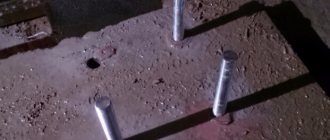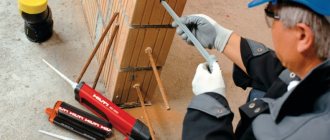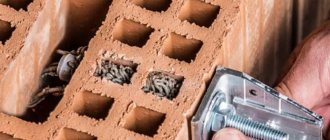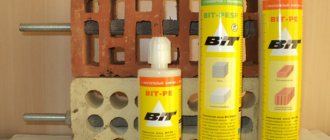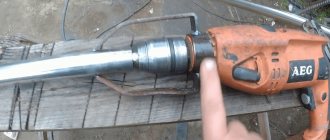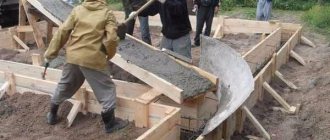A chemical anchor for concrete is a special, quick-hardening, semi-liquid mass that is glued into the mounting hole and becomes the basis for fastening bolts, metal threaded rods, metal rods, pins, etc. The fastening element is also called a liquid or injection anchor, or a chemical dowel.
Typically, a two-component synthetic resin is used as the basis of the composition, which ensures the connection and reliable fixation of metal materials in the monolith. This type of dowel is relatively new, but is already actively used in repair and construction work, allowing bolts and nails to be firmly secured in hollow, porous materials.
They are usually used where it is not possible to attach plastic or metal dowels - in hollow concrete structures, hollow ceramics, brick, expanded clay concrete, limestone, shell rock, sandstone. Chemical anchors for concrete are also relevant when working with dense concrete bases.
The composition of the chemical anchor: synthetic acrylate, polyester, polyurethane or epoxy resin for gluing, filler (sand, cement) and hardener to form a strong fastening base and make it possible to use the fastener after 1-10 hours.
Design and types
The design of a chemical anchor includes the following components: a special binder, a metal sleeve with a thread cut inside, an ordinary reinforcing rod or a metal pin with an external thread. Most often, the metal elements of a chemical anchor are made of stainless or galvanized steel with different strength parameters, which depends on the function of the fastener and operating conditions.
The main feature of this type of dowel is that glue is poured into the hole made in a porous or hollow material, which, after drying, guarantees the reliability of the connection. Where it is impossible or not relevant to use conventional anchors (they fall into voids and become loose or are not attached at all in a porous structure), it is now possible to perform fastening with a chemical anchor that can withstand a high load-bearing load and provides maximum strength.
Typically, manufacturers keep the recipe for the adhesive composition secret, but they usually use various types of synthetic resins for bonding, a filler for strength, and a hardener, which determines the quality and speed of hardening of the substance and turning it into a durable polymer. All components must be mixed immediately before installation is planned.
Forms of release of adhesive composition for chemical anchor:
1) Ampoules with resin and hardener - with a height and diameter corresponding to the dimensions of the bolt hole, are used to install one anchor. First, an ampoule is inserted into the hole, then a pin, which crushes the glass of the capsule (and the partition inside between the compounds, if there are two components) and starts the process of mixing the components.
2) Tubes and cartridges - the container in them is divided into two parts, with glue and hardener, used for installing a large number of chemical anchors using a special dispensing gun. The components are squeezed into the hole with a pistol, mixing at this moment, then a metal bolt is installed.
Hilti injection anchor systems
Calculation of electric current by power: formulas, online calculation, selection of machine
This type of chemical anchor (marked with the letters HIT) is a plastic cartridge with two sealed foil containers (one with adhesive filler, the other with a hardener). Today the company presents 7 varieties of this type of chemical anchor. The price of such anchors depends on the capacity of the cartridge (there are two types: 330 and 500 ml), the components of the composition, the area of application and the load that the stud installed with its use can withstand.
For example, the universal hybrid composition “HIT-MM-Plus” is a budget-class chemical anchor (the cost of one 330 ml cartridge is 650÷900 rubles). The two-component adhesive is made on the basis of urethane methacrylate. Recommended for installation of threaded rods in the range M6÷M16 in basic building materials such as brick (solid and hollow), lime-sand blocks, concrete, blocks made of cellular types of concrete, artificial and natural stone. For fastening studs in hollow blocks and bricks, the company offers specially designed perforated plastic sleeves, which increase the fastening strength and reduce the consumption of adhesive.
And the composition “HIT-RE-500-V3”, which closes the line of injection anchors, already costs 2700–3300 rubles for a package with a capacity of 330 ml and is intended for gluing the releases of working load-bearing reinforcement of floors, columns, foundations and flights of stairs. A composition based on epoxy adhesive with additives that allow the installation of studs and reinforcing bars with a diameter of 10÷55 mm even in holes completely filled with water.
We extrude the glue components using a mechanical hand dispenser. For chemical anchors with a capacity of 330 ml, the dispenser “HDM-330” is intended, for 500 ml - “HDM-500”. We insert the capsules into the plastic cassette of the dispenser (it is included in the kit), screw the mixer onto the threaded part of the cartridge (in which the components of the adhesive composition are mixed) and through its conical tube the glue enters the drilled hole. Parallel pistons are connected to the dispenser handle, and when it is pressed once, one portion of the adhesive composition (about 5 ml) is supplied.
Video about using the “HIT-MM-Plus” composition and the “HDM-330” dispenser:
For professional use in large volumes of anchoring work, the pneumatic dispenser “P-8000-D” and the battery dispenser “HDE-500-A22” are used.
Areas of use
Chemical anchors for concrete are most often used where there is a need for reliable and durable fixation of fasteners in porous, loose foundations. The viscous mass of glue penetrates into all the pores of foam concrete or aerated concrete, hollow brick, and during the hardening process it forms a strong and reliable connection of a metal bolt with the monolith of the structure with which it is connected.
Today, there is no alternative to a chemical anchor in cases where it is necessary to create a reliable fastening to hollow structures of objects of large weight and dimensions. Due to the fact that the glue does not expand during the hardening process and does not provoke bursting or wedging loads, fastening anchor bolts is effective in concrete and aerated concrete structures with a small cross-section of the material.
Chemical anchors are considered one of the most reliable types of fastening, and therefore they are used when installing balconies and bridges. Injection anchors are relevant when working with foam, slag concrete, cellular and slotted concrete where there are heavy loads: in the installation of fences, wall lanterns, supports, staircases, ceiling lamps, plumbing fixtures, canopies, suspended air conditioners, boilers, etc.
Fastening anchor bolts allows antennas, road billboards, advertising banners, and radio masts to withstand dynamic loads. It is also important that the fastening is not afraid of moisture and water, therefore it is actively used in hydraulic engineering and underwater structures - dams of various types, large and small swimming pools, large water parks, piers, etc.
Types of HILTI anchors
The unique hybrid chemical composition of anchors of this class makes them indispensable in construction, furniture production, and when performing minor repair work on household items. For each type of application, special, most suitable and easy-to-use polymer formulations have been developed.
- Hilti HIT-RE 500 chemical anchors are used in damp environments, damp concrete, and when installing load-bearing structures. These fasteners are indispensable when working in water.
- HILTI HIT-HI 70 is excellent for fastening parts to hollow (energy-saving) partitions, aerated concrete and other loose materials.
- HFX is suitable for home renovations, fastening household appliances and plumbing elements. It is extremely easy to use and does not require any special skills. It hardens quickly, is injected without a dispenser and allows you to get distracted for a short time if necessary. The degree of hardening is monitored by color changes.
- HIT-ICE works perfectly even at temperatures below -20 degrees Celsius. Dosed easily and quickly.
- HIT-RE 100 is a standard epoxy adhesive used for securing anchors and reinforcement in concrete foundations.
- HIT-HI 200-A is a unique development of a hybrid adhesive for the restoration of anchor connections and reinforcement outlets in critical areas.
- HIT-MM PLUS is an inexpensive and reliable material used for installation in concrete and brick.
Advantages and disadvantages
To understand what a chemical anchor for concrete is and where it can be useful (and where it will become the only possible method of fastening), it is necessary to study the main pros and cons of this type of connection.
Main advantages of chemical anchor:
- Maximum connection strength
- Safety and environmental friendliness (provided that non-toxic components are used in the production of the adhesive composition), no unpleasant odor
- Wide scope of use - on land and in water, inside and outside buildings, in dense materials and porous
- Does not provoke a tensile load, does not expand, does not produce expansion stress, so the chemical anchor can be used directly at the edge of the structure
- Simple, quick and easy installation – regardless of whether the chemical anchor is used in an ampoule or cartridge
- Ability to withstand severe tensile stresses
- Tightness - complete sealing of the hole where the anchor and bolt are inserted
- Service life is 50 years or more
- Resistance to negative atmospheric factors, corrosive, chemical, physical influences
- Resistance to shock and vibration loads
- Wide range of temperatures at which the anchor can be used - some manufacturers offer fasteners for installation at -18 and up to +40C
- Ability to use any fastener - smooth and grooved reinforcing bars, threaded bolts, bushings, pins and other metal elements
Among the disadvantages of chemical anchors, it is worth noting their high cost, short shelf life in the package (regardless of whether it is open or closed), and the inability to use all brands in the cold. Most anchors harden in 20 minutes to 6 hours, but if the temperature drops below -5C, not every adhesive will be able to provide adequate strength. But, for example, some Hilti chemical anchors can be installed at a temperature of -23C.
Certain difficulties may arise when using cartridges that require filling the hole with a maximum of two-thirds of the composition. It is not easy for beginners to immediately learn how to determine the degree of filling of the hole, which is why the glue can come out. When using ampoules, such a disadvantage is not observed.
Advantages of the Hilti HIT-RE-100 adhesive anchor
Main types of anchors: from classic bolts to dental pins
When using HIT-RE-100 adhesive for anchors in concrete, consumers can count on the following advantages of this product:
- Possibility of use indoors and outdoors with the base material, regardless of its current state (dried, moistened, filled with moisture, etc.).
- Large selection of additional accessories (metal brushes, electric dispenser, injection pistons).
- High level of efficiency for use in solid concrete foundations without cracks.
- Long curing period, due to which you can make the necessary adjustments during installation.
- Easy to clean, making installation much easier.
The cost of adhesive for anchors in concrete Hilti HIT-RE-100 starts from 1,500 rubles for a 330 ml container.
Types of chemical-based anchors, installation
All chemical anchors are divided into two main types depending on the form of delivery of the adhesive: capsule (supplied in tubes and cartridges) and ampoule (available as one-component and two-component). It is this difference that directly affects installation, suggesting different technologies for installing the anchor.
Installation of ampoule anchors
The adhesive substance is sealed in a glass cylinder; upon direct contact with air, the viscous mixture hardens. Installation is quite simple: first, mark the location of the fastener and drill a hole, then clean it of construction dust, insert an ampoule with an adhesive into the hole made with the required depth and size, and screw a pin or reinforcement into it. At the moment of screwing in, the ampoule cracks and the glue comes out into the hole, hardens and provides a reliable connection (pieces of glass additionally reinforce the fastener).
If the glue is made of one component, then the ampoule is simple; if it is of two, then two ampoules are used, one of which contains styrene. The speed of setting of the substance directly depends on the compliance with the instructions of the air temperature and the type of chemical anchor. Two-component chemical anchors are most often used where it is necessary to ensure maximum strength (fastener strength class is 5.8) and in conditions of high humidity, in water.
The disadvantage of this type of fastener is that if the anchor for a large hole is chosen incorrectly, the resin may not completely fill it and the reliability of the connection will be low.
Installation of injection anchors
The cartridge is a small container with a spout through which the adhesive mixture is squeezed out. A tube is a small reservoir of 400-800 milliliters, which is used together with a construction gun. In terms of one fastening, the cost of such a chemical anchor is lower than that of an ampoule, and there is a wider choice of filler. The adhesive anchor can be made not only from synthetic resin, but also from polyurethane and acrylate.
Installation is carried out as follows: mark the mounting location on the concrete surface, drill a hole, clean it, squeeze out the glue and insert the dowel. The glue becomes hard and provides a reliable, durable fastening; it is used for walls made of materials with voids inside.
Often, before squeezing out the glue, a perforated sleeve or plastic or metal is inserted into the material, which does not allow the resin to spread too much over the inner surface of the monolith. There are currently no other methods of fastening in hollow materials. Depending on the depth and size of the hole, one cartridge or tube charge is enough to make many fastenings.
DIY making
Chemical anchors for concrete are quite expensive, so sometimes it makes sense to make them yourself. Due to the fact that manufacturers keep the glue recipe secret, it will not be possible to reproduce exactly the same anchor. But it is quite possible to make reliable and durable fasteners from existing adhesives.
Typically, epoxy resin is used as glue - a relatively inexpensive, durable material that has excellent adhesion to various structures and can be used to install metal bushings, studs, fittings, etc.
How to prepare chemical anchor glue:
- Take a certain amount of epoxy resin (ED-20), mix with a plasticizer in a volume of 5-10% of the total mass (DEG-1, DBP and other additives).
- Mix with filler (gypsum or cement) in sufficient volume to obtain the desired consistency.
- Add hardener (UP-583) to the composition in a ratio of 1:8 to 1:10, mix thoroughly and use the mixture.
The main advantages of such a homemade chemical anchor: minimal shrinkage coefficient during the solidification process, good strength, high level of wear resistance, and the ability to use at temperatures from -10 to +35C. The composition hardens within 2 hours, gaining strength only after 12 hours. Such chemical anchors can only be used on well-dried surfaces. It should also be noted that the composition releases a small amount of phenolic compounds into the atmosphere.
Installation
1) Preparing the hole - the diameter of the hole for the chemical anchor must exceed the cross-section of the stud by 1.5-2 times. The place must first be marked, then drilled and cleaned of dust. If the anchor is installed in the cavity of a porous monolith, you need to insert a mesh sleeve into the hole.
2) Putting glue into a tube with a mixer attachment, installing the tube in a construction gun, squeezing the glue into the hole until it is two-thirds full.
3) Install the fastener into the hole until it stops.
Chemical anchors for concrete are high-quality and durable fasteners that meet all established requirements and standards. Can be used in the most difficult operating conditions, suitable for working with hollow and porous monoliths. By following technology and using high-quality materials, it becomes possible to make reliable fasteners that will serve for more than 50 years.


